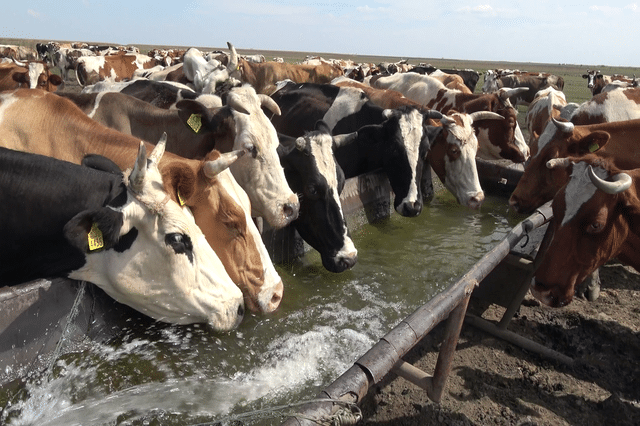Water is, of course, crucial for cattle, so before looking for an effective single cow milking machine that could make your life easier around the farm, you need to make sure that the animals are getting the necessary hydration, no matter the season and their location.
Unfortunately, many farmers and cattle owners sometimes take this resource for granted since they have solutions on their lands that are reliable most of the times, such as ponds. However, this doesn’t always mean that cattle have all the water they need since these spots can be low on water, they can dry out, or be subject to an interrupted flow of water.
Life expectancy without water
Before going into more details about what water means in terms of health and why one should do everything necessary to make sure it’s always available, let’s take a look at what the answer is for the main question of this article, namely how long can cattle go without water.
According to previous findings and to experienced breeders, cattle can go up to seven days without drinking water, which is significantly shorter than the sixty days they can last without food. This period also depends on outside temperatures since, if we’re talking about hot days, this period can be even less than the estimated seven days.
It’s a known fact that animals can go a lot longer without food than without water, and if the latter is not available, life expectancy drops to just a few days. Moreover, the sudden waves of heat that sometimes occur throughout the year taught producers that water can, in fact, be a very limited resource.
Other aspects worth considering
In extreme cases, farmers had to sell off large numbers of cattle because they were unable to secure the necessary resources and provide the continuous water supply that the animals needed. This can happen if the ponds dry up or if old pumps fail to work and therefore replenish the containers.
Depending on the location and on aspects that can change within the environment, water sources are also subject to contamination. Elements such as excessive nutrients or chemicals need to be taken into consideration when assessing the quality of the water provided to cattle since these can definitely have an impact on their health and productivity.
Water is crucial for health
One of the first things we learn in school is that the body of a mammal is made of about 60% water, this percentage being even higher in the case of young animals. You are most probably aware that water is crucial for a healthy organism, but you might not be exactly sure why this is.
This vital element transports nutrients between cells and it’s also crucial for intracellular metabolism. Since cattle are large animals, you should never neglect the importance of having a fresh source available at all times, even though listings of necessary nutrients often simply state “provide plenty of clean fresh water” without going into further details.
Water is also responsible for regulating the body’s temperature, as well as for the absorption and then utilization of nutrients within the body. Studies have also shown that there is a correlation between access to clean water and reproduction, productivity, and growth in cattle.
Moreover, research has also established that cattle that have access to clean, non-contaminated drinking water are actually less likely to deal with diseases and weigh more, given their improved health. For this reason, most cattle owners strive to maintain at least some control over the quality and quantity of water provided.
Experienced farmers have established best management practices when it comes to this matter, and they are well aware of the fact that if an animal is not in top shape, one of the first measures that need to be taken is to check that water source and see if there is any change in terms of quality.
Contaminants
Since this is a delicate aspect when it comes to water, we will take a moment and discuss contaminants separately. Livestock drinking water can be subject to contaminations from various agents, the most common ones including minerals (from manure, microorganisms, and other dissolved solids), as well as algae.
These have an impact on the odor, taste, and appearance of drinking water, but also on its chemical and physical properties. For this reason, certain contaminants can have a direct impact on an animal’s health, leading to potential diseases or infections.
On the other hand, other substances can have an indirect effect by causing cattle to drink less water if its taste or odor is affected. This, in turn, leads to a decreased food intake, which can mean fewer nutrients are processed, therefore exposing the animal to higher health risks.
Particularly sensitive categories, such as pregnant cattle, are prone to these issues that can also affect unborn calves. If the problem persists undetected, in the long run it can compromise development, growth, as well as milk production.
Water management
There are various measures cattle owners can take to improve the quality of the water provided to the animals. Many times, even small changes can make a significant difference. The first step that needs to be taken before anything else is a thorough evaluation of the situation in order to determine what needs to be done.
Some producers test the water for contaminants in this stage and, if issues are identified, they take the appropriate measures. Another important aspect to consider is that such an evaluation needs to be done regularly since conditions can change due to unforeseen factors.
What can be improved without too much hassle is ensuring the adequate water quantity for the number of cattle in a certain area. Moreover, watering devices need to be easily accessible, and if water is pumped from a stream or a spring as opposed to a pond, research has shown that cattle can actually gain more weight by 23%.
Once all of these details are assessed, you can determine what measures need to be taken in order to be ready for extreme cases as well, such as drought conditions. Experts can also help in this matter if you are not sure what the most appropriate solutions are for the area you live in.




